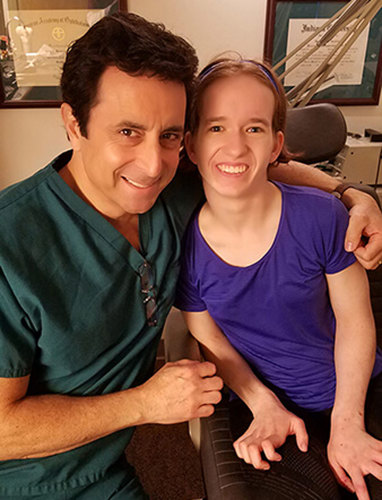Barry N. Wasserman, MD, a pediatric ophthalmologist and educator at Wills Eye Hospital in Philadelphia, was hard-pressed to select just one memorable case to share. As he explained, “My career is unusual in that I’m fellowship-trained in pediatric ophthalmology, but in the late ’90s, I had an opportunity to try refractive surgery. So now I have this weird practice where some days of the week I do pediatric ophthalmology and other days I do LASIK.”
This combination of interests and expertise led Dr. Wasserman to embrace an unusual niche: pediatric and special-needs refractive surgery. This is why he couldn’t choose just one case to describe.
“Each of my special-needs children is unique, and each case is rewarding in its own way,” said Dr. Wasserman. “Parents come to me when they’ve run out of other options for their children. These are children who have neurobehavioral issues associated with severe autism, as well as other syndromes. Often, they’re nonverbal and uncooperative. They won’t tolerate anything on or near their face, so eyeglasses aren’t an option. They can’t communicate verbally, and if their vision is impaired, they get trapped in this blurry world, which is scary for them. They’re often afraid of everything, and it spirals into what’s been described by Lawrence Tychsen, MD, as a ‘cocoon.’”

Refractive surgery for young special-needs patients requires pediatric general anesthesia, along with a team of nurses in the setting of a surgery center.
“For these special cases, we go to the Wills Eye Surgery Center, where a laser is rolled in, and I meet with the patient and our team to sedate the child,” Dr. Wasserman explained. “We perform much of the examination under anesthesia, then we perform our calculations, slide the patient under the laser, and treat their eyes. I generally perform PRK, mainly for safety. Some of these children may not understand or be able to comply if I tell them not to rub their eyes. Surface lasering minimizes that risk.”
Dr. Wasserman treats only a handful of special-needs children each year. He would do more, but he hasn’t been able to convince insurance companies to pay for it, as they still consider it a cosmetic procedure.
“This is a game-changer for these children, and ultimately they may need fewer health insurance dollars because they can be higher functioning,” Dr. Wasserman said. “It’s crazy that insurers won’t see that.”
As for measuring vision improvement, often success is detectable only by changes in a child’s behavior. “The impact that refractive surgery has not only on the vision, but on the lives and behavior of these special-needs children—in their ability to interact with other people and to grow and develop—is, many times, just breathtaking,” Dr. Wasserman said.
He recalled a particular young patient from the Midwest, who, during the long drive home after surgery, began looking out the window and engaging with the world like he’d never done before, according to the boy’s parents.
“In a letter, they included a picture of the family at the movies. They told me they never could go to a movie as a family before, because he couldn’t see anything and he couldn’t sit still,” Dr. Wasserman recalled. “Now that he can see, not only can he enjoy a movie, but the entire family can go out and do things together. His refractive surgery has impacted their entire family dynamic, and they were very grateful. It is a great privilege for me to do this. It’s truly a labor of love.”
For more information about Dr. Wasserman’s work at Wills Eye Hospital, visit www.willseye.org.








